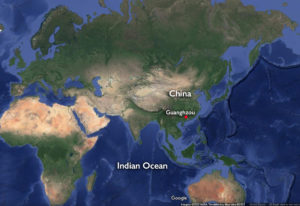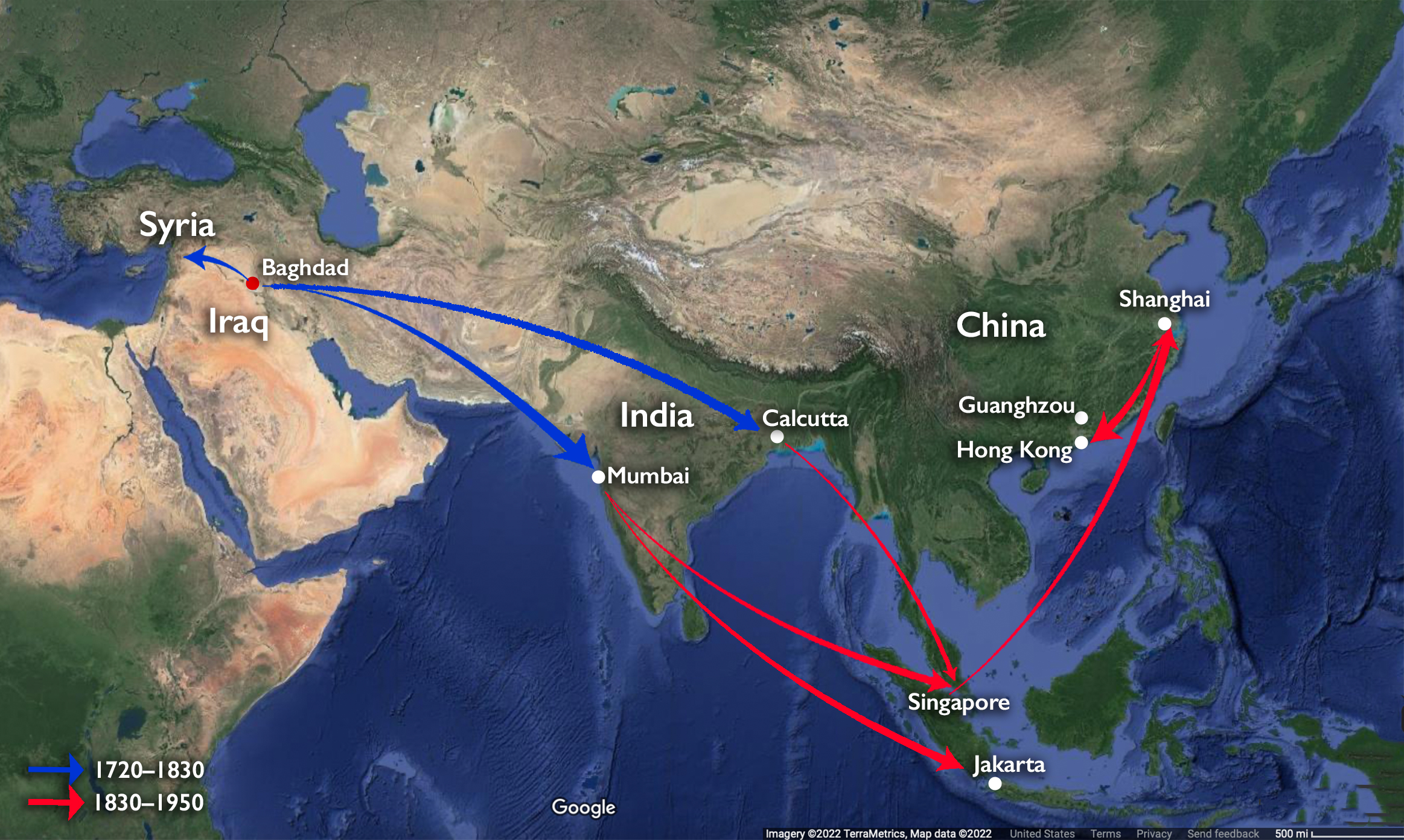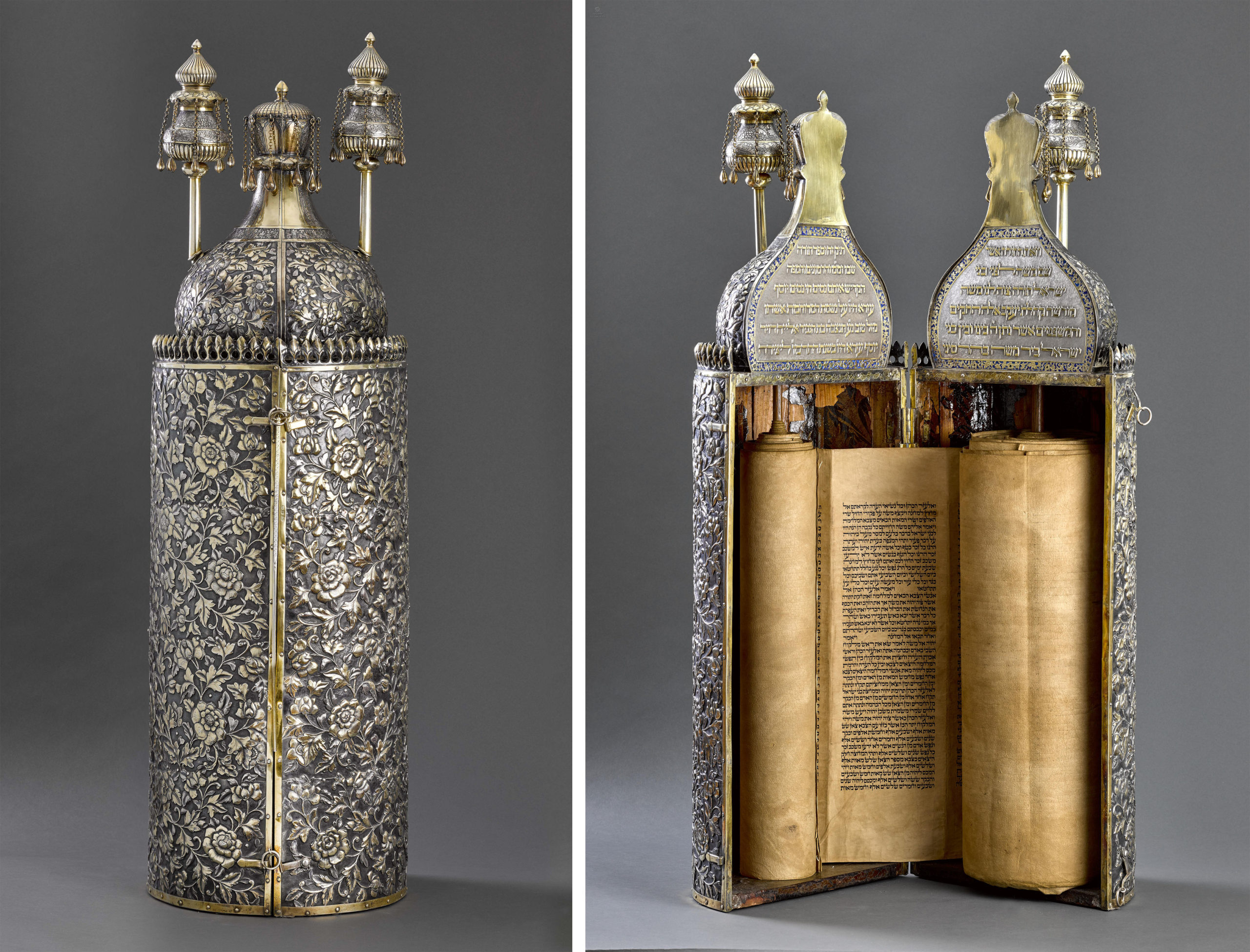
Torah case, 1886, Guangzhou, China, oxidized silver, silver, and silver-gilt, 92.6 x 30 cm (Center for Jewish Art)
What do China and India have to do with the form and decoration of a 19th-century silver case made for a Jewish community from Iraq? The decoration of this remarkable object speaks to the relationship of artistic production and global trade in the modern world.
This elaborate case (called a tik), adorned with scrolling vines and flowers, contains within it a Torah scroll, the holiest object in Judaism. The case, consisting of a cylindrical body and domed crown, is constructed of a wooden core with decorated silver plates adorning its exterior surface. The crown culminates in an undulating form with bells hanging on chains and two projecting finials (rimonim) surmounting the Torah’s staves. The hard case protects the scroll within while also enhancing its preciousness. When portions from the Torah are read during weekly services, the tik is positioned upright on a reader’s table and opened to reveal the scroll inside.
This particular Torah case was produced in Guangzhou, China in the late 19th century for a Jewish community originally from Iraq and by then living and working in both China and India. This Torah case is a rare Jewish example of Chinese export silver—silverwork made in China from the late 17th through mid-20th centuries that catered to foreign tastes.
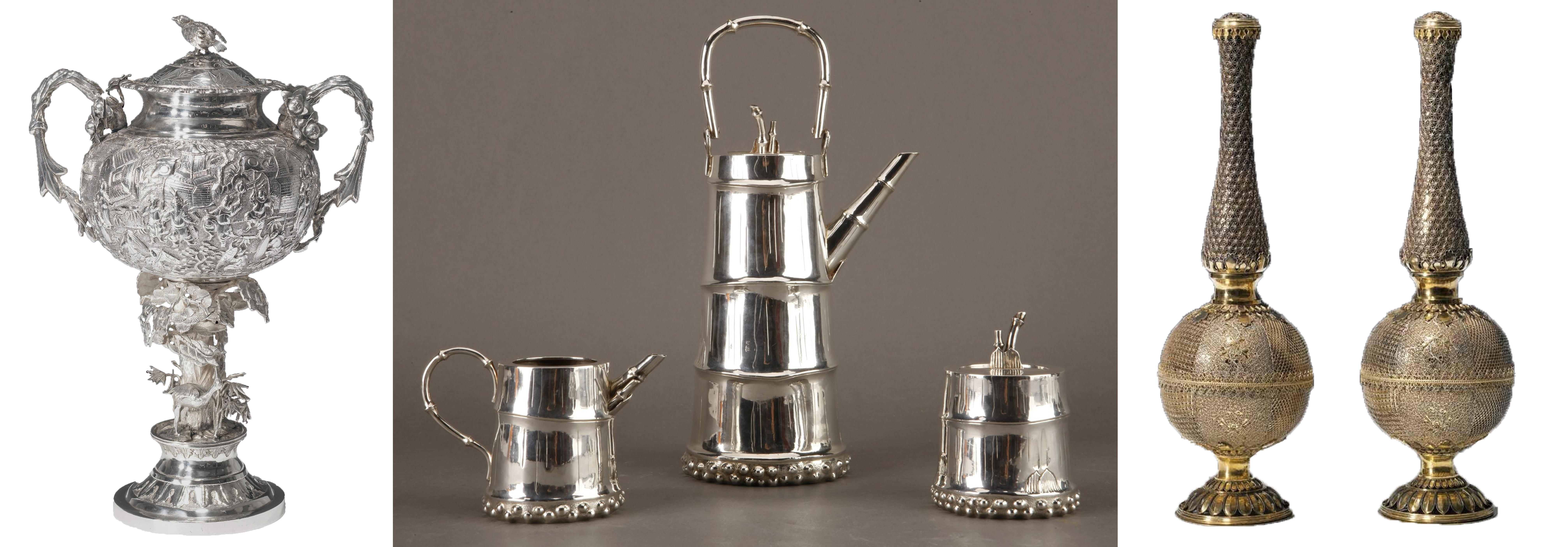
Chinese export silver. Left: standing cup with repoussé figures in landscape design and stand of pine tree and crane form, 19th century, Cumshing, Canton, silver 24 x 16.5 x 11.5 cm (Hong Kong Maritime Museum); center: set of bamboo-shaped tea service, 1900–10, silver (Hong Kong Maritime Museum); right: rosewater sprinkler with floral pattern, late 18th century, filigree silver, 16 x 9 cm (Hong Kong Maritime Museum)
Chinese export silver
Since the 16th century, spices, ivory, tea, silks, porcelain, and myriad other goods from China were shipped across the globe—to the Americas, Europe, and the Ottoman and Safavid Empires—through maritime and land trade networks. Along with the exchange of manufactured goods, silver also played a significant role in global trade. Beginning in 1565, Spanish trading ships known as Manila Galleons biannually traveled from the cities of Manila in the Philippines and Acapulco in Mexico bringing Asian luxury goods to Europe and the Americas in exchange for silver coins minted in Spain and Mexico. Silver coins quickly spread all over the world establishing a system of internationally accepted currency. But in China, and elsewhere, it was also used for making everyday and precious objects due to its bright color and its ease of working. Chinese silverware, including food containers, wine vessels, and objects for daily use, were decorated with subjects commonly found in Chinese painting and the decorative arts, such as bird-and-flower motifs and renderings of famous historical gatherings.
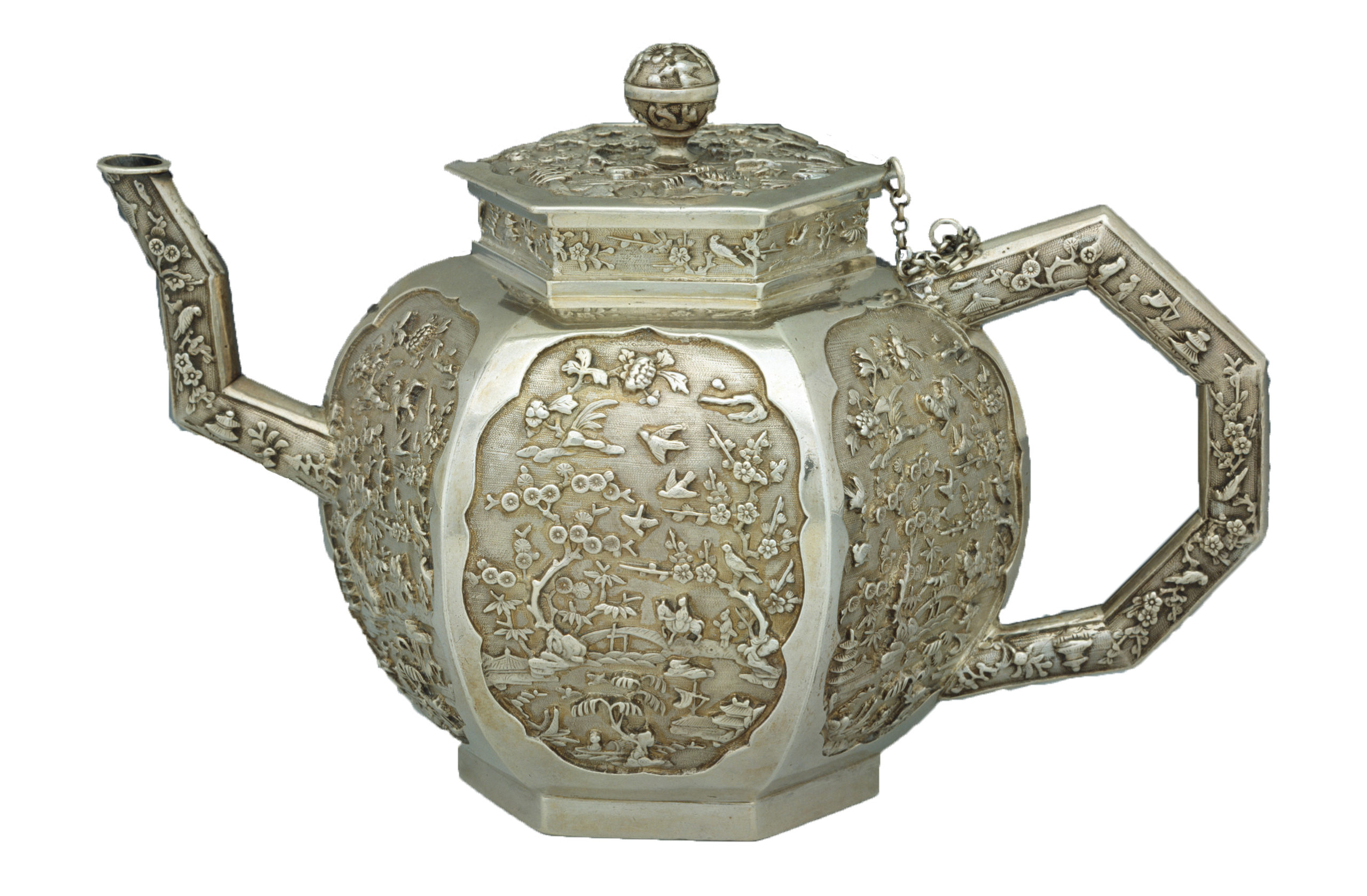
Teapot, 1680, China, silver, 13.97 x 21.59 x 11.43 cm (Peabody Essex Museum)
In the late 17th century, Chinese silver, including tea and coffee sets, tableware, card cases, snuff boxes, jugs, and Christian religious vessels, began to be produced specifically for export to Europe to cater to Western tastes. For example, this hexagonal teapot imported to London in 1682–83 includes scenes of a man set in a lush Chinese landscape of bamboo, pine, willow, and blossoming plum. This teapot, the earliest known datable Chinese export silver object, speaks to the early period of Chinese export silver, when imported objects bore traditional Chinese forms and decoration, such as bamboo stems and leaves, flying birds, and lotus flowers. By the 19th century, Chinese craftsmen adapted and combined Western-inspired forms and traditional Chinese design motifs, materials, and techniques to create new transcultural objects.
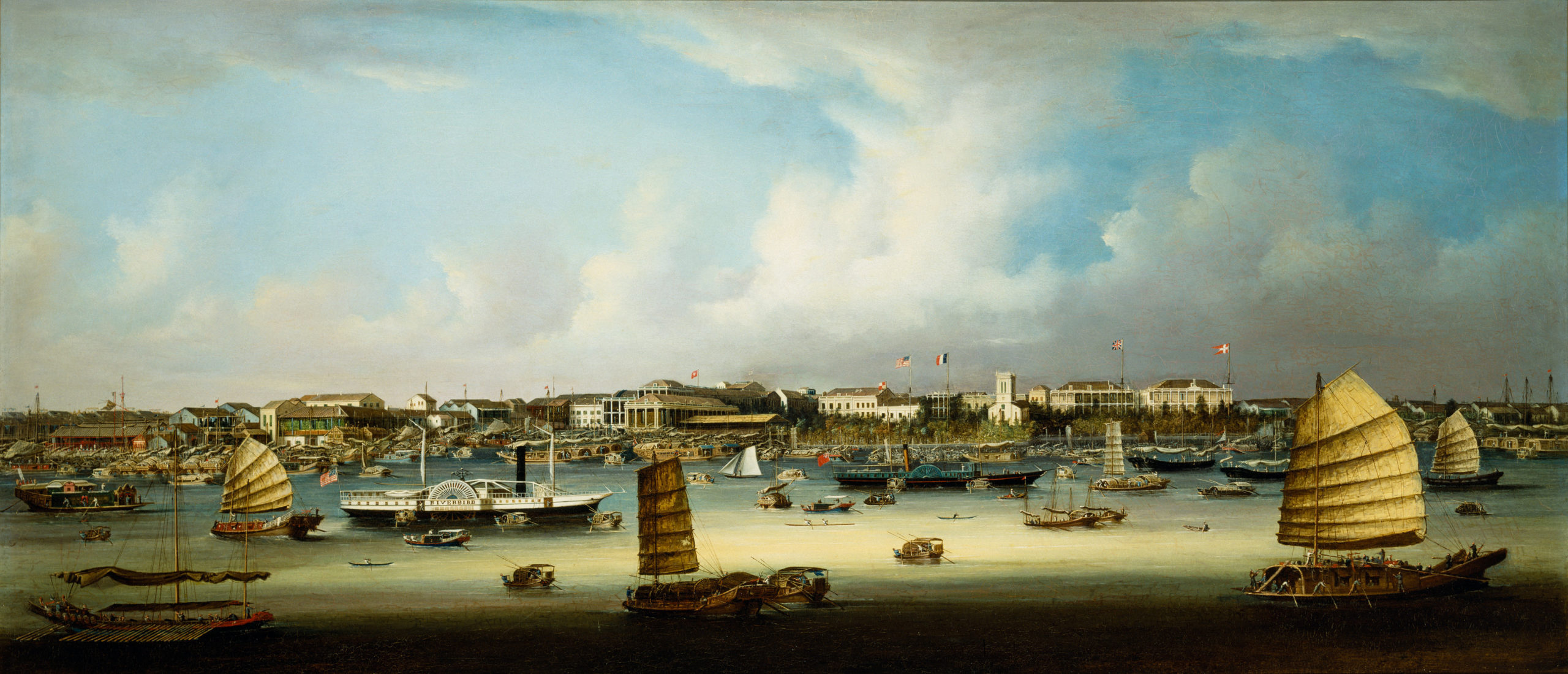
View of the foreign settlement in Guangzhou, 1855–60, Sunqua, oil on canvas, 80.8 x 184.5 cm (Peabody Essex Museum)
The Torah case that is the subject of this essay was produced in Guangzhou—a city on the south-east coast of China with a long history of maritime trade. It was one of the most important Chinese ports along the historic maritime Silk Roads. From the 4th century on, Guangzhou offered a viable route for traders to the South China Sea, the Indian Ocean, and the Persian Gulf region. Although already a centuries-long hub for global trading, Guangzhou became the exclusive port for foreign trade in 1757, when the Qianlong Emperor closed all other ports. The production and export of silver and all other goods for foreign trade was thus limited to the port city of Guangzhou. Foreign merchants—including Dutch, Portuguese, Parsi, Sindhis, and British, among others—established settlements in Guanghzou to use as their commercial base. As a result, the city emerged as a hub of cross-cultural interaction and artistic production.
However, almost a hundred years later, new trade horizons developed following the signing of the Treaty of Nanjing (1840–42), which permitted the opening of several new Chinese ports to foreign trade (Xiamen, Fuzhou, Ningbo, and Shanghai—as well as the cession of Hong Kong island to the British). Export silver workshops and foreign merchants relocated to cities surrounding these new ports to meet the new demands of a robust Chinese-European trade network. Although the centers of silversmithing largely shifted away from Guangzhou at this time, it continued to have some active export silver workshops, including the firm associated with the Guangzhou Torah case.
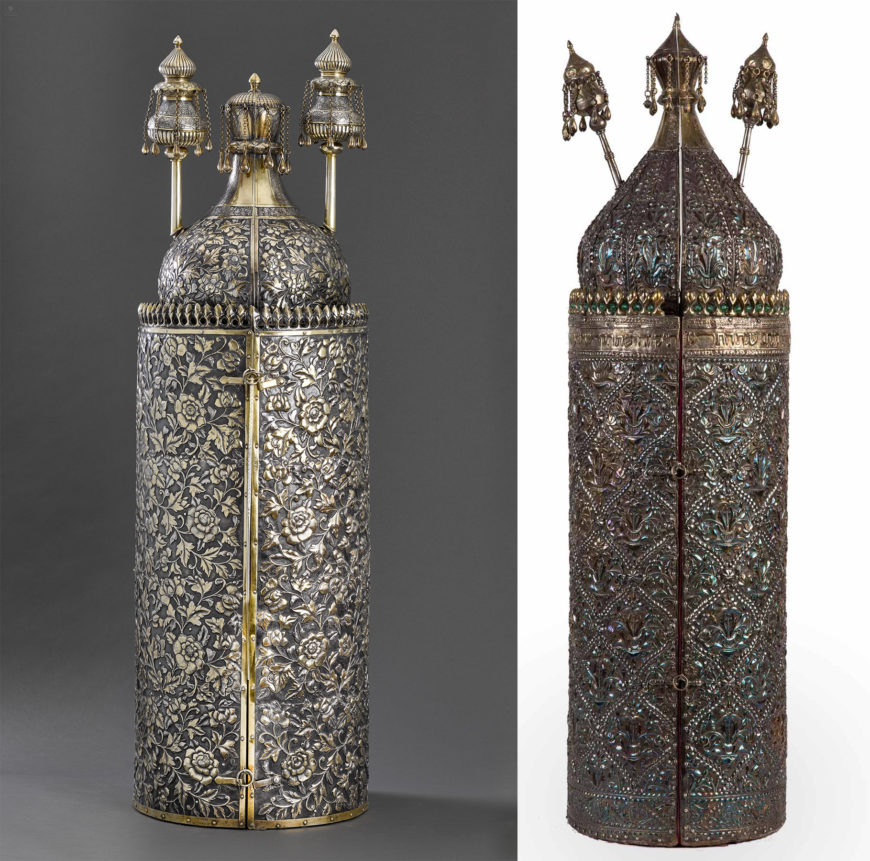
Left: Torah case, Guangzhou, China, 1886, oxidized silver, silver, and silver-gilt, 92.6 x 30 cm (Center for Jewish Art); right: Torah case, Iraq, 1897, silver and glass beads, 103.9 x 28.6 cm (Spertus Institute Collection)
An Iraqi Torah case made in Guangzhou
While the majority of Chinese export silver was made for European export and consumption, some works were produced for others engaged in Indian Ocean trade, including Jewish merchants originally from Iraq and now living in India and China. Far away from their Jewish spiritual center in Iraq, many Jewish merchants in India and China imported Jewish liturgical and ceremonial objects—such as Torahs and Torah cases—from Iraq, and commissioned Torah cases from artisans in China based on the model of Iraqi Torah cases. The Guangzhou Torah case is an example of a Torah case commissioned from a Chinese export silver craftsman.
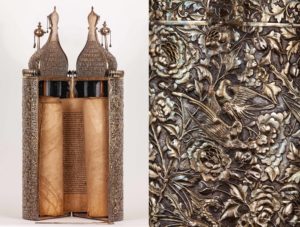
Torah case with flying bird motifs, China, 1891, silver, copper, gilt (Herbert & Eileen Bernard Museum of Judaica, Temple Emanu-El)
Like most Chinese export silver, the Guangzhou Torah case features a combination of techniques and forms—here, both Iraqi and Chinese. Like most Iraqi Torah cases, the Torah case is cylindrical in shape and made of wood covered with silver plates adorned with patterns in a technique called repoussé, which involves hammering from behind. However, the surface design differs significantly. Where Iraqi Torah cases typically featured motifs, such as vases with flowers enclosed within ornamental borders that created a net-like pattern across the case, the Guangzhou Torah case abandons the rhythmic rigidity of this design, and instead features rose-like flowers and buds whose vines scroll in all directions across the surface of the tik. This pattern is inspired by floral motifs commonly found in Chinese decorative arts, including porcelain, silver, and textiles. In fact, some of the Chinese export silver Torah cases featured other traditional Chinese patterns, such as bamboo stems and leaves, flying birds, and lotus flowers.
There are other differences between Torah cases produced in Iraq and those produced in China as well. Iraqi Torah cases often included inscription bands around the top, as well as crenellations ornamented with colored beads. Finally, the various elements of the design are treated differently. Where the Iraqi Torah cases primarily employed only silver and silver gilt, the Guangzhou Torah case, and other Chinese export silver Torah cases, also incorporated oxidized silver (silver purposely darkened using a chemical process). The contrast between the background of the case in blackened silver, and the floral motifs in both silver and silver gilt, created a more dramatic effect.
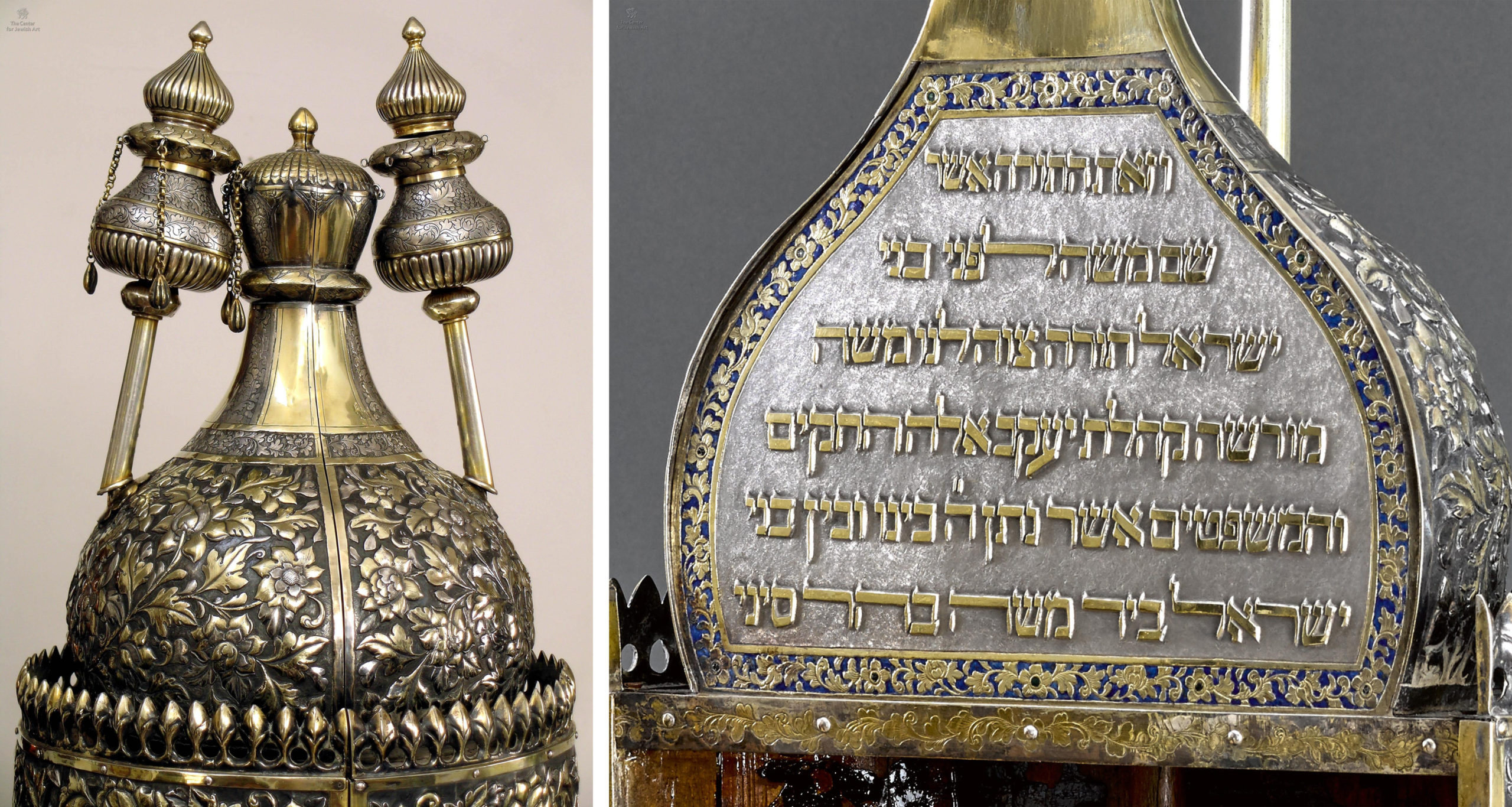
Left: Dome and finials; right: dedication inscription, Torah case, Guangzhou, China, 1886, oxidized silver, silver, and silver-gilt, 92.6 x 30 cm (Center for Jewish Art)
As in Iraqi Torah cases, the Guangzhou’s Torah crown and finials are integral to the case. When the case is opened, the inside of both halves of the crown display dedicatory plaques inscribed with biblical verses and details about the donors. But while Iraqi Torah crowns are typically onion-shaped, the Guangzhou crown is domed. Moreover, while Iraqi finials are set on a diagonal, are pear-shaped, and feature little-to-no decoration, the Guangzhou finials are vertical, undulating in form, and far more ornate with ornament matching the decoration of the case. These alterations offered more surfaces for the display of the silversmith’s skills. In addition to the decoration of the finials, the altered form of the crown created more space on the interior faces of the Guangzhou crown, where we find the sharp execution of large Hebrew letters raised in relief against a delicate background, all framed by an enameled frame of floral motifs. Throughout the decoration of the Torah tik, the Chinese silversmith moved beyond the model of Iraqi Torah cases, creating new patterns and designs that celebrated their craft.
Baghdadi Jews and Indian Ocean trade
According to the dedicatory inscriptions on the interior of the tik, the Guangzhou Torah case was commissioned by Nissim Hai, a Baghdadi Jewish merchant who lived and operated in Hong Kong and Singapore. He dedicated the Torah case in memory of his deceased wife Mazal Tov, from Calcutta (today Kolkata), India. Nissim Hai’s family, like many other Jewish merchants working in the Indian Ocean trade, traced their heritage to Baghdad, Iraq.
Beginning in the early 19th century, some Jewish merchants and their families living in the Ottoman Empire (and other regions throughout West and Central Asia) moved to British-controlled India and later to China. Many of the Jewish immigrants to India and China during this period came from Baghdad, and so the communities are commonly described as Baghdadi Jews. In East Asia, they established a Baghdadi diaspora, or communities of Baghdadi Jews separated from Iraq. From their bases in India and in China, they fashioned trade networks stretching from Shanghai to London through which they could distribute luxury goods. The intricate trade networks that they established were supported by a shared common identity and continuity across the many Baghdadi diaspora communities in India and China. Although they were surrounded by local Chinese, Indian, and Muslim populations, and others present in the region, for the most part, the Baghdadi Jews maintained a separate lifestyle. They kept strong ties with their Jewish cultural heritage and the spiritual and religious center of their community—Baghdad. They built synagogues and needed liturgical and ceremonial objects—especially Torahs and Torah cases—to fulfill the rituals of Jewish life.
In the early years of the Baghdadi Jewish presence in India and China, Jews commissioned Torah scrolls and cases from scribes and artisans still in Iraq, but by the late 19th century, just the Torah scrolls were imported from Baghdad, and the cases were produced in China in Chinese export silver workshops, based on the model of Iraqi Torah cases. The Guangzhou Torah case is an example of Chinese export silver Judaica.
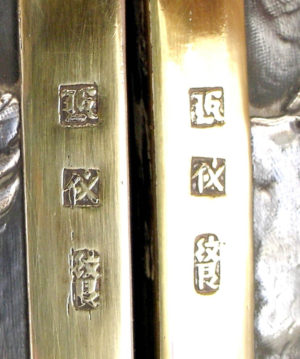
Stamps, Torah case, Guangzhou, China, 1886, oxidized silver, silver, and silver-gilt, 92.6 x 30 cm (Center for Jewish Art)
While we don’t know the specific artist that created this Torah case, the firm that produced the case can be associated with the production of several other works of Jewish art. Three marks in Chinese characters and Latin letters can be seen stamped along the Torah case’s front bars. Beginning in the 1840s, Chinese silversmiths began to stamp their works with marks that indicate information about the object—one of the case’s three marks includes the letter “K.” This letter has been connected to a retail Chinese export silversmith active in Guangzhou between 1840 and 1875, who created other works of Chinese export silver Judaica, including two Torah cases and a case for a scroll of the Book of Esther (Megillat Esther). Clearly, there was substantial demand for Chinese export silver Judaica among the Baghdadi communities of India and China.
We also do not know the synagogue in which this Torah case was originally used. It’s possible that it was donated to a synagogue in Hong Kong or Singapore, where Nissim Hai (its patron) lived and worked. It is also possible that it was donated to a synagogue in Calcutta, where the family of Mazal Tov, Nissim Hai’s wife, was based. In fact, the Torah is known to have arrived in Israel in the 20th century from Calcutta. In the second half of the 20th century, many of the Baghdadi Jews left India and China for England, North America, and Israel. When they moved, they took their ceremonial objects with them, including their Torah scrolls.
Made in China, and used in China or India (or possibly both), this Torah case is a unique product of the transnational artistic and cultural networks forged by the Baghdadi Jewish community in the 19th century.
Additional resources
The Silver Age: Origins and Trade of Chinese Export Silver (Hong Kong Maritime Museum)
Art of the Qing Dynasty
Chiara Betta, “From Orientals to Imagined Britons: Baghdadi Jews in Shanghai,” Modern Asian Studies 37.4 (2003): 999–1023.
Libby Chan, “Crossing the Oceans: Origins and Redefinition of Chinese Export Silver Ware,” The Silver Age: Origins and Trade of Chinese Export Silver, edited by Libby Lai-Pik Chan and Nina Lai-Na Wan (Hong Kong Maritime Museum, 2017), pp. 157–89.
Adrien von Ferscht, “Understanding Chinese Export Silver Marks”
Henry Forbes, John Crosby, and Ruth Wilkins, eds., Chinese Export Silver, 1785 to 1885 (Museum of the American China Trade, 1975).
S.R. Goldstein–Sabbah, “Transnational Networks and the Baghdadi Diaspora,” in Baghdadi Jewish Networks in the Age of Nationalism (Brill, 2021), pp. 69–108.
Takeshi Hamashita, “Silver in Regional Economies and the World Economy: East Asia in the 16th to 19th Centuries,” in China, East Asia and the Global Economy: Regional and Historical Perspectives, translated by J.P. McDermott (Routledge, 2008), pp. 39–56.
Maise Meyer, Shanghai’s Baghdadi Jews: A Collection of Biographical Reflections (Hong Kong: Blacksmith Boos, 2015).
Jay Waronker, “Baghdadi Synagogues of India: Their Design Roots, Aesthetic, and History,” The Baghdadi Jews in India: Maintaining Communities, Negotiating Identities, and Creating Super-Diversity, edited by Sahlva Weil (Routledge, 2019), pp. 39–56.
Bracha Yaniv, “The Story behind a Baghdadi Torah Case,” Windows on Jewish Worlds: Essays in Honor of William Gross, collector of Judaica on the Occasion of hush Eightieth Birthday, edited by Shalom Sabar, Emile Schrijver, and Falk Wiesemann (Walburg Pers, 2019).

